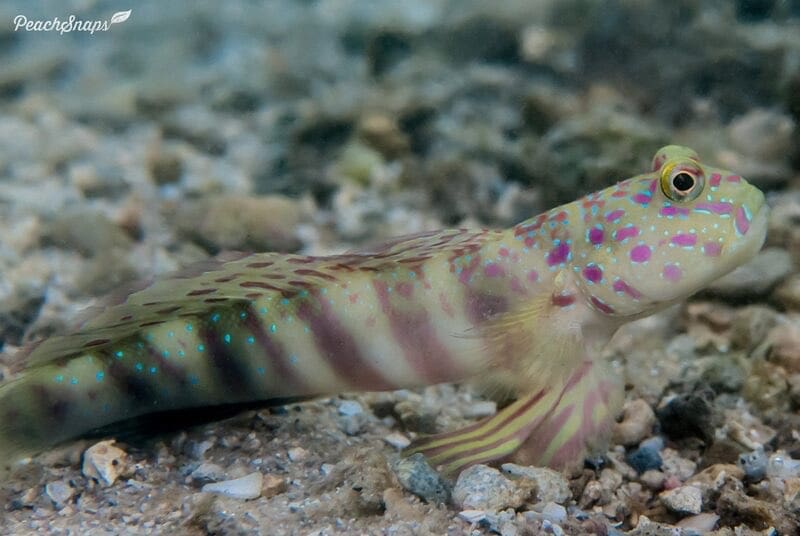The pink spotted shrimp goby (Cryptocentrus leptocephalus) is a small but fascinating fish that is well-loved by divers and aquarium enthusiasts alike. Known for its striking appearance and unique symbiotic relationship with shrimp, this goby brings color and intrigue to coral reef ecosystems. With its pale body adorned with bright pink spots and its captivating behavior, the pink spotted shrimp goby is a must-know species for anyone interested in marine life.

Appearance and Habitat
The pink spotted shrimp goby is easily recognizable thanks to its light body color, ranging from white to beige, and its bright pink or red spots that cover its head and sides. Its eyes are large, and it has a distinctive dorsal fin, often flaring it up as a defensive measure or to communicate with its shrimp partner.
This species is commonly found in the Indo-Pacific region, inhabiting sandy areas around coral reefs at depths of 5 to 30 meters. Unlike many reef fish, the pink spotted shrimp goby prefers sandy or muddy bottoms rather than coral structures. It spends most of its life close to the seabed, where it builds its burrows in collaboration with a shrimp.
Symbiosis with the Pistol Shrimp
One of the most fascinating aspects of the pink spotted shrimp goby is its symbiotic relationship with the pistol shrimp (Alpheidae). This relationship is a perfect example of teamwork in nature. The goby provides protection for the shrimp by acting as a lookout, using its sharp eyesight to detect predators. In exchange, the shrimp uses its digging skills to create and maintain a shared burrow, where both creatures live.
The shrimp is nearly blind, making the goby’s sharp vision essential for their survival. While the shrimp is busy digging and maintaining the burrow, the goby keeps watch. If danger approaches, the goby signals the shrimp with a flick of its tail or body movement, and both retreat into the burrow until the coast is clear. This partnership is not only mutually beneficial but also a charming example of nature’s interconnectedness.
Behavior and Diet
Pink spotted shrimp gobies are generally peaceful, spending most of their time near their burrows, popping in and out to feed or guard the entrance. They primarily feed on small invertebrates, plankton, and detritus that they find in the sandy substrate. Their diet makes them an important part of the coral reef ecosystem, as they help keep the seabed clean and free of excess organic matter.
Despite their small size, pink spotted shrimp gobies can be quite bold when it comes to defending their territory. They are known to flare their dorsal fin and make quick darting movements to deter potential intruders.
Funny Encounters with the Pink Spotted Shrimp Goby
Divers often share amusing stories about these curious little fish. One tale comes from a diver who was observing a pink spotted shrimp goby diligently guarding its burrow while its shrimp partner was busily excavating sand. As the shrimp threw sand out of the burrow, it accidentally buried the goby under a small pile of sand. The goby shook itself off, gave the shrimp a quick look (as if to say, “Watch where you’re throwing that!”), and went back to its guard duties.
In aquarium settings, many hobbyists enjoy watching the goby and shrimp work together. One aquarium owner shared a funny story about how their pink spotted shrimp goby seemed to have developed a playful routine of stealing food intended for other fish. Whenever the food was dropped into the tank, the goby would dart out of its burrow, snatch up the food, and quickly disappear back into hiding, leaving the other fish puzzled.
Importance in the Ecosystem
The pink spotted shrimp goby plays a vital role in maintaining the health of the sandy reef environments it inhabits. By feeding on small invertebrates and cleaning up detritus, it helps keep the substrate clean and balanced. Its burrowing behavior also helps aerate the seabed, contributing to the overall health of the reef ecosystem.
Furthermore, the goby’s symbiotic relationship with the pistol shrimp is an important example of cooperation in nature. This partnership ensures the survival of both species in a competitive environment, highlighting the delicate balance of life on coral reefs.
Fun Facts About the Pink Spotted Shrimp Goby
- Tail Communication: The goby communicates with its shrimp partner by flicking its tail to signal danger.
- Homebody: Pink spotted shrimp gobies rarely venture far from their burrow, as they rely on it for safety.
- Tiny but Tough: Despite their small size, these gobies are highly territorial and will fiercely guard their burrow from intruders.
Frequently Asked Questions About the Pink Spotted Shrimp Goby
What is the Pink Spotted Shrimp Goby?
The Pink Spotted Shrimp Goby, scientifically known as Cryptocentrus leptocephalus, is a species of goby native to the western Pacific Ocean. It is renowned for its symbiotic relationship with pistol shrimps, where the goby acts as a lookout while the shrimp maintains their shared burrow.
What does the Pink Spotted Shrimp Goby look like?
This goby features a pearly-white to tan body adorned with distinctive pink spots and smaller iridescent blue spots. It can grow up to 4 inches (10 cm) in length.
What is the natural habitat of the Pink Spotted Shrimp Goby?
The Pink Spotted Shrimp Goby inhabits silty substrates in coastal reefs, lagoons, mangrove swamps, and tide pools of the western Pacific Ocean.
What is the symbiotic relationship between the Pink Spotted Shrimp Goby and pistol shrimp?
In this mutualistic partnership, the nearly blind pistol shrimp maintains the burrow, while the goby stands guard at the entrance, alerting the shrimp to potential dangers. This relationship benefits both species by providing shelter and protection.
Is the Pink Spotted Shrimp Goby suitable for home aquariums?
Yes, this goby is considered reef-safe and is popular among aquarists. It requires a minimum tank size of 30 gallons with a sandy substrate for burrowing and a tight-fitting lid to prevent jumping.
What should I feed my Pink Spotted Shrimp Goby?
As a carnivore, it thrives on a diet of small meaty foods such as mysis shrimp, brine shrimp, and finely chopped seafood. Feeding should occur at least twice daily to ensure proper nutrition.
Can I keep multiple Pink Spotted Shrimp Gobies together?
It’s best to keep only one per tank unless you have a mated pair, as they can be territorial towards their own species.
Are there any special considerations when housing this goby?
Ensure the tank has ample hiding spots and a sandy substrate for burrow construction. Also, be cautious when housing with small ornamental shrimp, as larger gobies may view them as prey.
Final Thoughts
The pink spotted shrimp goby may be small, but it’s a big deal in the world of marine life. Its unique relationship with the pistol shrimp, combined with its colorful appearance and important role in the ecosystem, make it a fascinating species to observe. Whether you’re a diver hoping to spot one in the wild or an aquarium enthusiast keeping one at home, this little fish is sure to captivate your attention.
Check out our next article about: Green Turtle


Leave a Reply